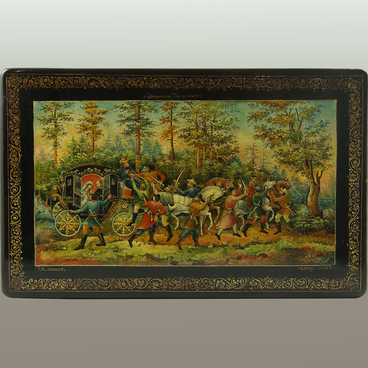The panel painting “Pottery” was created to decorate one of the halls of the House of Culture of Industrial Cooperation in Leningrad (built in 1931–1938, since 1960 it has been the Palace of Culture named after the Lensoviet). In total, there were four panel paintings, and two of them were donated to the Russian Museum in 2001.
The panel painting was created by Ivan Ivanovich Zubkov (1883–1938, Palekh, Ivanovo region). The artist studied at the icon-painting workshop of the Belousov brothers (1893–1896), and worked there until 1917. He painted icons, frescoes, was engaged in the restoration of fresco painting. He was a member of the Artel of Ancient Painting since December 5, 1924 and one of its seven founders.
In addition to miniature painting on papier-mâché, Palekh atists often turned to monumental and decorative painting. Panels were made on canvas or wooden boards. The theme of the panel “Pottery” is connected with one of the important activities of the trade cooperation system — handicraft production of clay products. The panel was painted in 1932, when hundreds of potters were working in many regions of Russia. There was even a collective farm specializing in ceramics and called “Red Potter”.
From left to right, scenes of the life of the pottery peasant craft unfold on the panel: the extraction of clay — with buckets from a well dug in the place where the clay was deposited, — the transportation of clay to the village, the preparation of clay for work (on a fenced area it is crumpled with bare feet, adding water). The finished clay “dough” is brought to the pottery workshop, where vessels are formed on hand wheels. At a distance from the houses, kilns for firing were dug in the ground — large pits, from where the already burned dishes are taken out. Finished products — pots, jugs, vases, and whistles — are placed in a cart and sent to the fair.
The creative manner of the Palekh craftsman, hereditary icon painter Ivan Ivanovich Zubkov, is distinguished by love for a simple Central Russian landscape. Zubkov’s works are always recognizable, he depicts trees in such a peculiar way: slender, with thin trunks and sprawling light crowns, they make the pictorial space look like theatrical backstage. Each tree has its own characteristic leaves, a special color, but everything seems to be permeated with thin golden strokes.
The panel painting was created by Ivan Ivanovich Zubkov (1883–1938, Palekh, Ivanovo region). The artist studied at the icon-painting workshop of the Belousov brothers (1893–1896), and worked there until 1917. He painted icons, frescoes, was engaged in the restoration of fresco painting. He was a member of the Artel of Ancient Painting since December 5, 1924 and one of its seven founders.
In addition to miniature painting on papier-mâché, Palekh atists often turned to monumental and decorative painting. Panels were made on canvas or wooden boards. The theme of the panel “Pottery” is connected with one of the important activities of the trade cooperation system — handicraft production of clay products. The panel was painted in 1932, when hundreds of potters were working in many regions of Russia. There was even a collective farm specializing in ceramics and called “Red Potter”.
From left to right, scenes of the life of the pottery peasant craft unfold on the panel: the extraction of clay — with buckets from a well dug in the place where the clay was deposited, — the transportation of clay to the village, the preparation of clay for work (on a fenced area it is crumpled with bare feet, adding water). The finished clay “dough” is brought to the pottery workshop, where vessels are formed on hand wheels. At a distance from the houses, kilns for firing were dug in the ground — large pits, from where the already burned dishes are taken out. Finished products — pots, jugs, vases, and whistles — are placed in a cart and sent to the fair.
The creative manner of the Palekh craftsman, hereditary icon painter Ivan Ivanovich Zubkov, is distinguished by love for a simple Central Russian landscape. Zubkov’s works are always recognizable, he depicts trees in such a peculiar way: slender, with thin trunks and sprawling light crowns, they make the pictorial space look like theatrical backstage. Each tree has its own characteristic leaves, a special color, but everything seems to be permeated with thin golden strokes.






